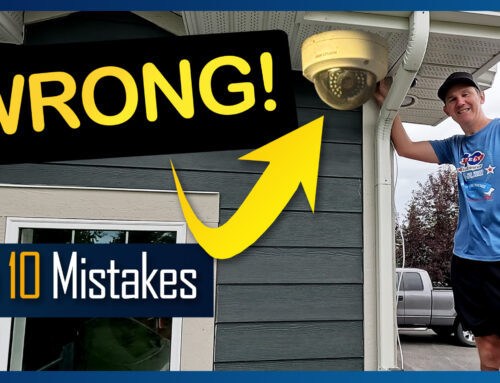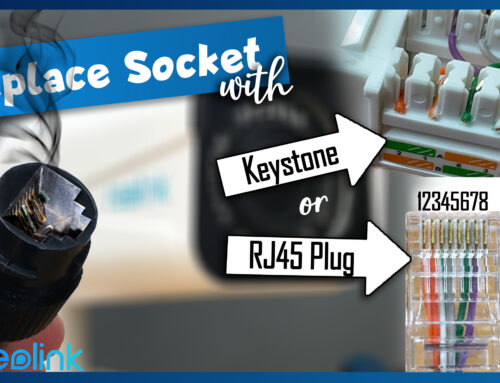Today we’ll be taking a detailed look at Reolink’s TrackMix WiFi security camera. We’re going to set this camera up in a couple locations where we can best review its footage, examine its features including auto-tracking. There’s lots of information coming your way, all important to know before you buy.
Winter has set in, and all my outdoor tests are performed in temperatures as low as -25c or -13f. Just check out the frost on those antennas. Using a thermal imager, you can see I really put this camera to the test. Brrrrrr.
REOLINK Outdoor PTZ Camera with 256GB microSD Card Bundle, 4K 8MP, 2.4G/5GHz WiFi, Color Night Vision, Auto Tracking, 6X Hybrid Zoom, TrackMix WiFi
Let’s check out the specs and start off with what’s at the end of the 2 foot or 60cm cable coming from the back of the camera. This is of course the 12v power plug-in. Paired with it, we have the optional RJ-45 network connection, for the data interface.
Next, we have the mount. It’s a part of the camera’s structure, so there’s nothing to assemble or parts to figure out. It allows for a wall or ceiling mount and like the rest of the camera, it’s super solid and well-designed. Feeding the cable through a hole offers more protection to the wires and gives a nice clean, professionally installed look. Oh yeah, I only used 2 screws in this little demo, but 4 are recommended. Without using a wire hole, here’s how the wire would be placed in the mounting groove. And here is a quick view of how to install this under an eave or on an overhang mounting surface. They’ve really made this part easy.
The camera comes equipped with 2 beefy and durable Wi-Fi antennas. They support both the standard 2.4 and 5GHz frequencies that pretty much everyone uses in their homes. Brace yourself, we’re heading outside to test the range at 300ft away. Not sure how well you can see it, but the camera is located here.
Let’s jump into the security camera to see what it sees. Since the device has 2 cameras, the wide-angle view is here on the left and the zoom on the right. More to come on their specifications later. Here I am, right here. As I approach the camera, it picks me up and follows me around. It was able to stream all that footage back to my house, without losing any frames or quality. Pretty impressive.
Moving onto the back of the camera, we have the speaker. There is an alarm which can be triggered from the app, or when motion is detected. The camera is located right here. This camera also offers 2-way audio, which of course is paired with the mic here on the front. Let see how well the mic picks up my voice from 100ft away. Reolink recently made some updates with the audio and it’s sounding just perfect now.
Here on the bottom of the camera, we have a weather proof door. Beneath, there is a factory reset button. Press and hold the button using a pin for 10 seconds to reset the device. Just above that, we have a micro-SD card slot, for cards up to 256GB. The camera allows for continuous recording or just when motion is detected. 64GB card, will provide about 20 hours of footage. A 256GB card, will give you close to 80. This means, a computer or NVR is not required to save footage and works perfectly as a stand-alone device, without having to purchase anything more than a memory card.
On that same topic, you may know that I am a fan of the Security Camera Management tool for PC called Blue Iris. This camera works great with that tool. Turn on RTSP and ONVIF in the camera’s advanced settings. In Blue Iris, add the cameras like so. Pause the video if you need to see the exact settings. Each camera from this device needs its own channel. Pretty cool, and I’ve been using it for a while now, and Blue Iris handles the feed perfectly.
On top of the lens, we have the camera’s night vision IR lights. These are designed to see up to 30m or 100ft away. Here I am at that distance away at the end of the driveway. Yes, you can see me, but the detail isn’t great. They definitely more effective with half that distance. By default, they are configured to turn on and off automatically depending on ambient light conditions.
The lighting sensor for the IR lights and night vision is here, between the 2 lenses. Under the lens, we have 2 spotlights. These are quite bright at 450 lumens. These can be manually activated or set up to come on when animal, person or vehicle motion is detected. They can also be setup to turn on and off on a schedule. With the lights on, as I appear from around the corner, you can see how amazingly bright these lights really are. As I get closer the camera adjusts to keep a good image of me.
Here is some sample footage at night in my yard. Here we are with no IR or spot lights. I’m really impressed, great detail in complete darkness. If I turn it towards the sky, look like Orion’s Belt is visible, pretty cool.
Moving onto the lenses. The lens on the camera’s right side is the wide-angle lens that records at a constant, panoramic 104-degrees in 4k. Nice and wide and definitely covers an impressive area at its best quality. The other camera, records at 2k but its lens offers optical zoom from 2.8mm up to 8mm; all at an impressive aperture of f1.6, which allows a lot of light to enter the camera in light-challenging conditions. The viewing angle for this lens is also 104-degrees at its widest, but when zoomed in, the angle is 38-degrees. I love how the wide angle ensures no details are missed while to zoom lens catches details up close. It’s a very impressive setup.
The pan and tilt limits are 0-355-degrees for the horizontal plain and 0-90 for the vertical.
Ubiquiti Dual Band IEEE 802.11a/b/g 5.30 Gbit/s Wireless Access Point - Indoor/Outdoor
Alright guys, time for some final thoughts of what I liked and disliked.
For my dislikes, there are a couple and pretty minor. Since I exported a lot of footage for this review. I use the Reolink PC app a lot and in order to save footage, I need to download the 2 channels, for each camera, individually. Thankfully on the NVR or a mobile device the 2 tracks are downloaded together, which I like. The second issue, is how the camera outsmarted itself by anticipating motion by tracking the vehicle to the left. The camera turned too close to the pole and lost sight. A corner mount could help prevent this, or setting limits within the app, preventing the camera from going outside of areas where there will be no action.
Ok things that I like: I like how quickly the camera returns to its home position after an object it was tracking goes out of range. I like how there is little lag considering there are 2 video feeds streaming over one WiFi connection. I like how well it performed in cold weather and how well it works with Blue Iris. Lastly, of course is the auto-tracking. You have that 4k panoramic shot maintaining over 100 degrees of coverage and a 2k camera zooming in an pulling out details. And it’s versatile, meaning it works great for larger areas under surveillance, or on smaller properties.
Links for the camera, micro sd-card and blue iris are in the description. I hope you found this video helpful, so you know exactly what to expect if you decide to pick up this camera or the PoE version. Please hit that thumbs up button and subscribe so you don’t miss out on more home tech diy projects you can do yourself.
REOLINK Argus 4 Pro, 4K Solar Security Cameras Wireless Outdoor, 8MP for Home Security, ColorX Night Vision, 180° No Blindspots, 5G/2.4GHz WiFi 6, AI Detection, No Monthly Fee, Home Hub Compatible
⚡⚡⚡⚡ Amazon:⚡⚡⚡⚡
👍 Reolink TrackMix WiFi on Amazon: https://amzn.to/49bLvkO
👍 Ubiquiti U6 IPX5: https://amzn.to/4ciQctH
👍 Recommended Micro-SD memory Card: https://amzn.to/49bLvkO
😁😁😁 DEALS on Reolink.com 😁😁😁
👍 TrackMix WiFi: https://reolink.com/product/reolink-trackmix-wifi/?aff=216
👍 TrackMix PoE (no WiFi): https://reolink.com/product/reolink-trackmix-poe/?aff=216
👍 RLN8-410 NVR: https://reolink.com/product/rln8-410/?aff=216
Reolink NVR’s compatible with the TrackMix WiFi: https://support.reolink.com/hc/en-us/articles/900002812986/
💻💻💻💻 Blue Iris 💻💻💻💻
😀😀😀 Download, Demo and Buy Blue Iris: http://www.hometechdiy.com/buy-blue-iris/























